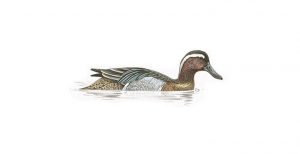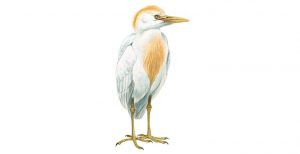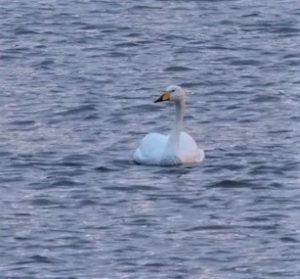After the spectacular early summer weather we experienced, the months of July through to September were a little more mixed.
There were still plenty of hot spells, but these were interspersed by the odd week of unsettled weather, including Storm Francis in late August. Temperatures were generally at or above normal, while rainfall gradually recovered to more typical levels as the period progressed.
As in recent summers, Fleet Pond was again negatively impacted by a blue-green algae bloom. It was more serious this year, and a contributing factor in the mass mortality of fish on August 11th. As for the birds, they largely managed to survive the event although there was a noticeable exodus of Great Crested Grebes at around this time.
Quiet july
July was rather uneventful with only a few notable sightings to report. Up to six Common Terns were present for much of the month, including one juvenile (raised elsewhere), while the only migrant wader of note was a single Redshank on July 25th. A flock of 150 Sand Martins present on July 7th was a good count, up from the more usual 40 and no doubt included an influx of migrants, while Swift passage included 152 logged heading west on July 25th.
Activity picked-up markedly in early August with migrant and returning wildfowl. Four Shoveler sighted on August 3rd were the prelude to another good early autumn for the species. Numbers built to 11 by the end of August, 28 by September 9th and peaking at an impressive count of 61 on September 21th before falling back.
Teal were also more in evidence with high counts of 15 on August 9th and September 16th. More exciting was the appearance of a first year male Garganey (male in breeding plumage, illustrated below) on August 6th that remained in residence into October but throughout its stay it was remarkably elusive, and was often ‘missing’ for weeks at a time, such is the maze of islands it could lose itself in. Other notable wildfowl sightings in August included an unexpected flock of four male Pochard on August 22th, with six present on 24th and up to four Mandarin Ducks throughout.
Cattle egrets—new visitors to the pond
The late afternoon of August 11th produced one of the surprises of the year; three Cattle Egrets (single, in summer plumage illustrated below)perched on dead alder branches on Cormorant Island in the middle of the Pond. With this sighting a new species was added to Fleet Pond’s bird list.
The trio ended up roosting overnight on one of the willow islands, along with ten Little Egrets, but sadly they were not seen the following morning. Cattle Egret is another species that is gradually expanding its range northwards from the Mediterranean into the UK. Hampshire’s first successful breeding took place at a coastal site in 2019 and the species is now well established west of us in the Somerset Levels. However, Cattle Egret is a scarce bird away from a few favoured southern locations, and this sighting represents the first record for north east Hampshire and takes Fleet Pond’s bird tally to an impressive 228 species! Despite regular observation of the reserve’s small roost of Little Egrets thereafter, no further sightings were made.
The remainder of August’s sightings were pedestrian by comparison, with migrant waders represented by Green Sandpiper from August 6th into mid-September, Common Sandpiper on August 10th, a Dunlin at Sandy Bay and a Greenshank both on August 14th and the first Snipe of the autumn on August 16th. The only gulls of note were an adult Yellow-legged Gull who dropped in briefly on August 4th, a small movement of Herring Gulls over southwest that same day and a juvenile Common Gull present on August 8th.
Mid-August saw a pick-up in passerine migrants, including Tree Pipits (2 on 12th and singles on 13th, 17th and 18th), up to five Sedge Warblers, two Spotted Flycatchers and a high count of 27 Whitethroats, both of the latter primarily around the MoD fields and eastern boundary of the Reserve on August 17th.
The MoD fields continued to be productive in early September with a Redstart (female illustrated above), up to two Whinchats and eight Stonechats on September 1st-2nd increasing to 12 on September 15th. Summer migrants quickly disappeared as the month progressed with the last Swift seen on September 1st, Willow Warbler and Spotted Flycatcher on 7th, Reed Warbler on 10th and Hobby on 18th.
Other September notables included a flock of 200 House Martins swarming over the Pond on 11th, a high count of 25 Chiffchaffs on 25th, and a Dunlin seen in flight over the Pond on 26th.
Wildfowl continued to be a highlight into September and besides the aforementioned influx of Shoveler, sightings included several flocks of migrant Tufted Ducks, the largest comprising 23 on September 21st, five Wigeon on September 16th, with further pairs of Wigeon on 17th and 19th and up to seven Mandarin Ducks (illustrated below) present throughout.
Roosting geese included counts of 632 Canada Geese and 194 Greylag Geese noisily leaving the reserve at sunrise on September 16th, the latter’s tally only pipped by a count of 205 on August 21st.
Surprise visitor—whooper swan
September’s highlight, and probably the most unanticipated bird of 2020, was the discovery of an adult Whooper Swan cruising the Pond on the evening of September 26th. Staying overnight, the swan departed early on the morning of 27th. Throughout its short stay it was chased a few times by our resident Mute Swans, but managed to find some undisturbed areas to successfully rest and feed. Whooper Swan is a very scarce winter migrant to southern England and this sighting coincided with a handful of others that were recorded at sites scattered around England on this particularly early autumn date. It is likely this individual overshot its intended destination and probably originated from eastern Scandinavia or points further east. This is the first record of Whooper Swan at Fleet Pond since two adults touched down briefly on October 22, 1994. (Whooper Swan pictured below, by John Clark)
Awaiting the winter visitors
As autumn progresses and the days shorten, attention turns to the arriving winter visitors and the several thousands of birds that will start to use Fleet Pond as their preferred evening winter roost site. Already we are seeing up to 300 Jackdaws roosting at the reserve as well as lesser number of Starlings and Magpies.
As usual, the weather will influence the birding over the coming months and what treasures there are out there to find. Good birding!
William Legge
Contributing Observers: David Buckler, John Clark and Graham Stephenson.
Illustrations credit: www.rspb.org.uk/birds-and-wildlife/wildlife-guides/bird-a-z/





